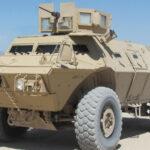Defense technology startup Anduril has revealed its latest development in the field of autonomous aerial warfare—a vertical takeoff and landing (VTOL) fighter jet concept called “X-Bat.” Designed to operate without a human pilot onboard and powered by artificial intelligence (AI), the aircraft is positioned as a next-generation unmanned combat aerial vehicle (UCAV) capable of dogfighting. The unveiling signals a significant shift in how future air dominance may be achieved—through software-defined autonomy rather than sheer platform size or speed.
What Is the X-Bat? A Software-Defined Autonomous Fighter
The X-Bat is a conceptual unmanned fighter aircraft developed by Anduril Industries in collaboration with Shield AI. It merges advanced autonomy software with a vertical takeoff and landing (VTOL) airframe—enabling operations from austere environments without runways. The aircraft is reportedly designed around Shield AI’s Hivemind autonomy stack and Anduril’s Lattice OS mission system.
While detailed specifications remain undisclosed due to the prototype status of the project, early renderings suggest a jet-powered delta-wing configuration optimized for maneuverability rather than loitering endurance. The design appears to prioritize agility over payload capacity, aligning with its stated role as an autonomous dogfighter.
The aircraft is not yet operational but is part of Anduril’s broader strategy to develop modular autonomous systems that can scale across mission sets—from ISR to offensive counter-air. The company has not confirmed whether a full-scale demonstrator has flown yet.
AI Autonomy at the Core: Shield AI’s Hivemind and Lattice OS
The real innovation behind the X-Bat lies in its software backbone. Shield AI’s “Hivemind” is an onboard autonomy stack trained through reinforcement learning simulations and real-world flight data to perform complex tasks such as navigation, threat avoidance, target acquisition—and eventually—air-to-air combat maneuvers without human input.
Hivemind has already been integrated into smaller Group 3 UAVs like the V-BAT (also built by Shield AI), which have demonstrated autonomous operations in GPS- and comms-denied environments. The system uses onboard sensors—including EO/IR cameras and radar—to perceive surroundings and make tactical decisions in real-time.
Lattice OS from Anduril complements this capability by serving as a mission-level command-and-control interface that allows operators to task multiple assets simultaneously across domains. Together, these systems aim to deliver scalable autonomy that can be deployed across swarms or mixed manned-unmanned teams.
Dogfighting Without Pilots: Ties to DARPA ACE and Project VENOM
The concept of an autonomous dogfighter aligns closely with ongoing U.S. Department of Defense initiatives such as DARPA’s Air Combat Evolution (ACE) program and the USAF’s Project VENOM (Viper Experimentation and Next-gen Operations Model). Both efforts seek to validate whether machine learning agents can outperform human pilots in beyond-visual-range (BVR) or even within-visual-range (WVR) engagements.
- DARPA ACE: Focuses on developing trustworthy human-machine teaming for air combat using simulation-trained agents capable of executing split-second maneuvering decisions during dogfights.
- Project VENOM: Involves retrofitting F-16s with autonomy kits for live testing of AI-pilot performance under real flight conditions starting in FY2024–2025.
X-Bat appears aimed at leapfrogging these testbeds by offering a purpose-built platform that eliminates the need for legacy pilot interfaces altogether—freeing up design constraints such as cockpit ergonomics or life support systems.
Tactical Use Cases: Loyal Wingman or Standalone UCAV?
Although still conceptual, X-Bat could serve multiple roles depending on how it integrates into broader force structures:
- Loyal Wingman: Operate alongside manned fighters like F-35s or NGAD platforms as expendable sensor/shooter nodes capable of high-risk maneuvers without endangering pilots.
- Saturation Attacker: Swarm enemy IADS or contested airspace using coordinated tactics alongside other UCAVs or loitering munitions.
- Aggressor Drone: Provide realistic training scenarios for human pilots during Red Flag-type exercises using adversarial maneuvering logic learned via simulation.
- Crisis Response Asset: Deploy rapidly from forward bases or naval vessels due to VTOL capability—ideal for Indo-Pacific A2/AD environments where runways may be unavailable or targeted early in conflict.
Industry Implications: Disruptive Entry into High-End Air Combat
The unveiling of X-Bat underscores how defense startups like Anduril are challenging traditional primes by leveraging commercial tech stacks—such as cloud-based simulation environments—to accelerate development cycles. Unlike traditional programs that span decades from concept to IOC (Initial Operational Capability), companies like Anduril aim for rapid iteration through digital engineering pipelines and software-first architectures.
This approach aligns with recent Pentagon priorities under Replicator Initiative frameworks emphasizing attritable drones deployable at scale within two years—not two decades. If successful, platforms like X-Bat could redefine procurement models away from monolithic billion-dollar jets toward distributed networks of cheaper but smarter assets powered by edge-AI decision-making loops.
Caveats and Unknowns
- No flight test data or timeline has been released; it remains unclear when—or if—a prototype will fly operational missions.
- No information on propulsion type, stealth characteristics, range/payload specs have been disclosed publicly; all current visuals are conceptual renders only.
- The legal/ethical framework for lethal autonomous weapons remains unsettled; deployment would require policy clearance beyond technical feasibility alone.










